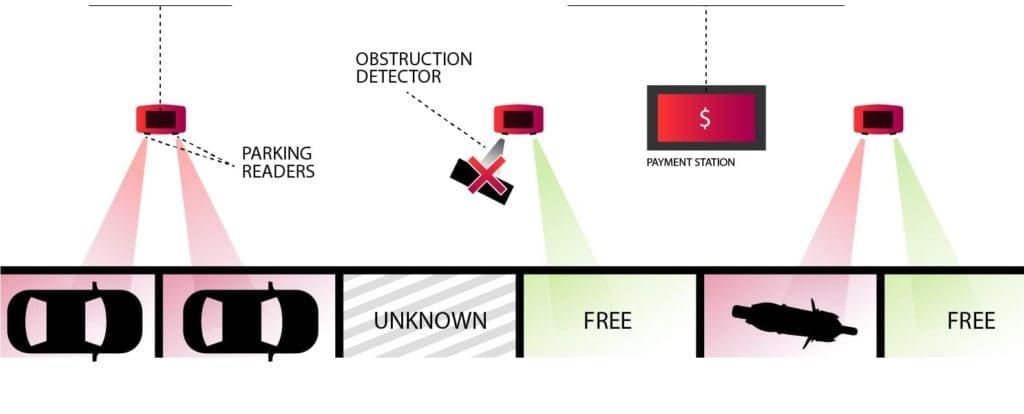Dimonoff is honoured to be named the 2025 Green Tech Award winner in the Smart City Lighting category by Digi International.
Solving Curbside Parking Scarcity Through Availability Information
Cities often focus on the financial benefits of curbside parking management systems skipping the key information: parking availability data.
Curbside parking is a vital aspect of urban mobility in cities. With the advent of smart parking solutions, managing curbside parking has gotten easier. Despite this, city representatives often focus these technologies on the financial benefits, such as issuing parking tickets. While this may be a quick fix for generating revenue, it does not address the underlying problem of parking scarcity. It rather leads to a lack of attention to the most critical information needed to manage curbside parking effectively: street parking availability information.
The lack of available parking spaces is a major challenge for citizens. They often struggle to find parking spots, which results in driving around for extended periods causing congestion and pollution. In contrast, city authorities can make more informed decisions when managing curbside parking by focusing on street parking availability information.
For example, they can use real-time data from sensors and other technologies to determine which parking spaces are currently in use and which ones are available. This information can be used to adjust parking regulations, such as adjusting parking times or fees, to encourage drivers to use available parking spaces rather than parking in restricted areas.
Creating New Revenue Streams Using Parking Availability Information
Knowing the availability of parking spaces also has the potential to provide more revenue than just issuing parking tickets. With dynamic pricing strategies, cities can adjust parking rates based on demand, ensuring that parking spaces are always available for those who need them. This not only helps cities generate revenue but also ensures that parking spaces are being used efficiently.
Are You Also Looking to Enhance Curbside Parking Experience?
Cities can use real-time data to provide accurate information about available parking spaces. This information, which can be made available through mobile applications or digital signs, widely improves the curbside parking experience. Citizens will spend less time searching for parking and more time enjoying the amenities and attractions that the city has to offer.
Another challenge with curbside parking is the inefficient use of space. Parking spots take up a significant amount of space on the street, which could be used for other purposes, such as bike lanes, sidewalks, or green spaces. The inefficient use of space can also result in increased traffic congestion and pollution, as cars circle in search of available parking spots. As a matter of fact, the IPMI (International Parking & Mobility Institute) Emerging Trends in Parking report reveals that:
“Many of the technology improvements dovetail with the parking industry’s drive to make parking more environmentally sustainable by reducing the time it takes to find parking, decreasing fuel consumption and fuel emissions.”
Modernizing Curbside Parking Management Systems
At a second level, there are various challenges when implementing curbside management solutions.
One of the primary challenges is the lack of power supply that restricts the deployment of sensor-based technologies requiring continuous energy to function effectively. Without power, sensors cannot monitor parking spaces, collect data, or transmit information to users in real time. Dimonoff has developed wireless, battery-powered sensors that are easy to install and offer maximum durability to tackle this problem.
Another challenge is that urban infrastructure and vegetation (trees) often pose a challenge when installing cameras and other sensors. However, Dimonoff’s wireless parking space detectors can be integrated to urban furniture, such as bollards, which eliminates the need for sensors to be installed on the ground.
In addition, cameras are not always well received by the public, and some citizens may have concerns about their privacy. However, Dimonoff‘s wireless sensors do not capture any personal data, which eliminates the need for citizens to worry about their privacy.
Lastly, the installation of sensors in the ground can pose several challenges. Street works or snow removal can damage the sensors. Installation in the ground can also be against the Americans with Disabilities Act (ADA) rules. Dimonoff’s wireless sensors can be installed without causing any disruptions to the street, and they do not violate any ADA rules.
In conclusion, while the financial benefits are important when managing curbside parking, cities focusing solely on revenue generation can lead to a lack of attention being given to critical information such as parking availability. By prioritizing street parking availability information, city representatives can make more informed decisions about managing curbside parking, reducing congestion, creating new revenue streams, promoting a more sustainable environment and using space more efficiently.
Author: Eric Dusablon
VP Business Development. Projects are driving my career. Managing successfully complex teams and complex projects with key developers is a great feeling. Realizing the best solution to a problem is the only reward. If it is new, if it helps somehow to resolve a problem, if there is a balance between challenge and budget. It is made for me!























